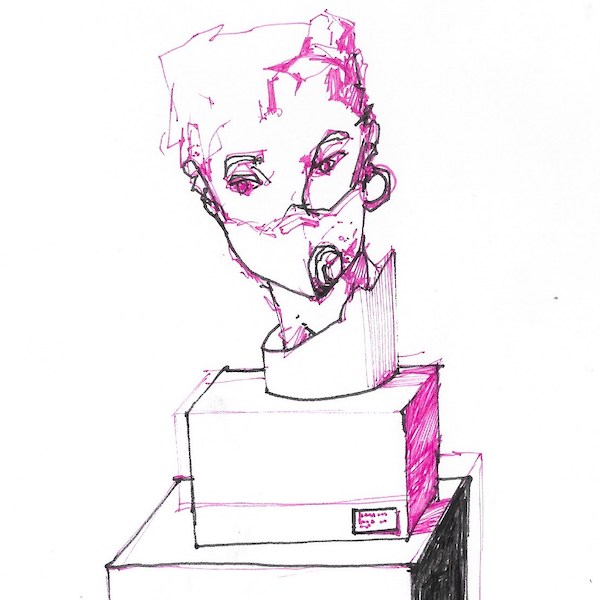You could draw people in masks. Paint them. Paint on them. Make videos where the face above changes but the mask does not, challenging the viewer to notice and read the eyes, the hairline. You could fashion new masks or sculpt respirators. And the gloves, too: photograph the wet slack way the human hand, medically gloved, becomes reptile now.
It might be within a stones’ throw of what you were up to anyway, all the years you spent in school and then after looking for your exact thing. It might speak to your established themes as they say. There might be a virtual group show about it, the virus, and you might be in it because you made the art with gloves and masks.
It might be a slow day at some paper, some site, someone’s twitter. They might go “Wow the art about the people in masks? That’s The Art We Need Right Now.” You might get in. For the first time—noticed—because you made the art about the right horror at the right time.
People will ask: How did it hit you, this image? The lower half of the face erased. Are they bandits? Doctors? Antifa? Terrorists? What does it mean to wear a mask? Are you a futurist now?
Some foundations and funds will get involved, and independent and, if you’re lucky, wholly-dependent curators. You have this whole room, floor, gallery to yourself. Have you ever been to Paris? Welcome!
In months or years we’ll have moved on to a new crisis, but you’re in, and that’s what matters. People have invested in the idea that you’re good. Having waterskied in holding tight to the Topic (no shame in that, we all have to work the inadequate lanes they give us) you now have to bring Topics to you. Convince people your latest obsession is as relevant as your last. Those masks? All part of a bigger mythology, see? Now I’m doing anatomies, barrels, ears, noses and throats.
Art is always supposed to be responding, reacting, expressing what’s changing, but artists who are most sensitive to those changes or enamored of those changes or just plain willing to exploit temporary public fascination with them have a tricky path. Art is slow and the news is fast—although there’s always art willing to respond to the big-T topics and there will always be column inches devoted to that art, the most celebrated art is never that. Fairly or unfairly the incisive, insightful, thought-provoking, specific and above-all fast reaction to 9/11 or Katrina or Corona never quite makes it onto the decade’s Top 10 lists.
War memorials get close (there will always be another war): Guernica by being, let’s face it, vague and the Vietnam Wall for proving ordinary people might have a use for minimalism, but the top spot is usually reserved for something that cuts obliquely across a decade of headlines, capable of somehow answering the anxieties of any number of curators.
Deep down, this rests on the assumption that life is slow: of a piece, summarizable, full of thoughts absorbed here that are also useful there. And art, being slow, has thrown in its lot with this view: you can’t do everything, everyday. You back up and take life at a distance.
And art is getting slower, relatively, because its done in the face of a metastasizing variety of creativities that touch the news closeup, responding fast, one topic and then the next, one season and then the next, a meme and then the next. The culture at large has never had a faster response time or such a rich toolkit with which to design those responses. We will never win a contest of quick wit.
When I say art is slow that isn’t a value judgment in either direction: the lone, unsupported human making a thing to be shown in a special room months or years after it was conceived is the baseline pace for fine art. Is that how life works still? Life might actually be unsummarizable, and the only universal experience might increasingly just be: One thing and then the next.
When asked what art is doing in the face of this crisis or the last one we should also ask why so often we just can’t do crisis. To choose fine art is, for the most part, to choose to be slower than anything you might call a “response.” Let’s make sure we’re making that choice consciously. Do we love what is slow for some reason other than wishing this up-to-date life away? And what uses do we put our slowness to?
Illustration by Zak Smith.


